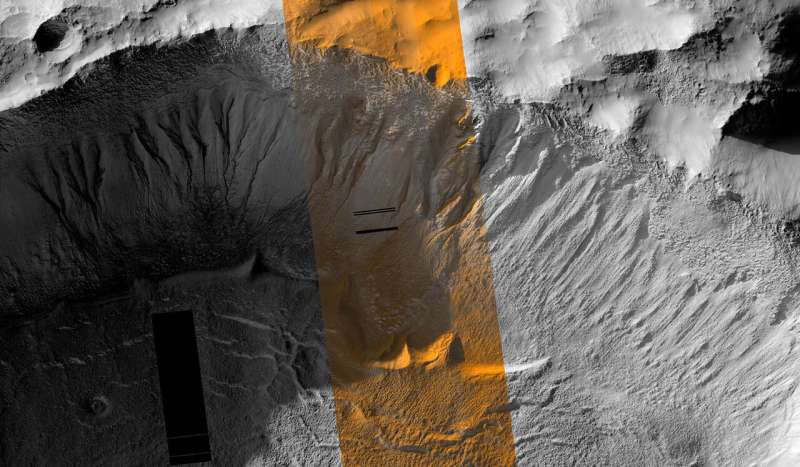This article has been reviewed according to Science X's editorial process and policies. Editors have highlighted the following attributes while ensuring the content's credibility:
fact-checked
peer-reviewed publication
trusted source
proofread
Gullies on Mars could have been formed by recent periods of liquid meltwater, study suggests

A study led by Brown University researchers offers new insights into how water from melting ice could have played a recent role in the formation of ravine-like channels that cut down the sides of impact craters on Mars.
The study, published in Science, focuses on Martian gullies, which look eerily similar to gullies that form on Earth in the Dry Valleys of Antarctica and are caused by water erosion from melting glaciers. The researchers, including Brown planetary scientist Jim Head, built a model that simulates a sweet spot for when conditions on Mars allow the planet to warm above freezing temperatures, leading to periods of liquid water on Mars when ice on and beneath the surface melts.
The scientists found that when Mars tilts on its axis to 35 degrees, the atmosphere becomes dense enough for brief episodes of melting to occur at gully locations. They then matched the data from their model to periods in Mars history when the gullies in the planet's Terra Sirenum region are believed to have expanded rapidly downhill from high elevation points—a phenomenon that could not be explained without the occasional presence of water.
"We know from a lot of our research and other people's research that early on in Mars history, there was running water on the surface with valley networks and lakes," said Head, a professor of geological sciences at Brown. "But about 3 billion years ago, all of that liquid water was lost, and Mars became what we call a hyper-arid or polar desert. We show here that even after that and in the recent past, when Mars' axis tilts to 35 degrees, it heats up sufficiently to melt snow and ice, bringing liquid water back until temperatures drop and it freezes again."
The findings help fill in some of the missing gaps on how these gullies formed, including how high they start, how severe the erosion is and how far they extend down the side of craters.
Previous theories suggest Martian gullies were carved by carbon dioxide frost, which evaporates from soil, causing rock and rubble to slide down slopes. The height of the gullies made many scientists theorize that meltwater from glaciers had to be involved because of the distance they traveled down the slopes and how eroded the gullies looked. Proving liquid water could exist on Mars since it disappeared so long ago has been difficult because temperatures typically hover about 70° below freezing.
The results from the new study suggest that gully formation was driven by periods of melting ice and by CO2 frost evaporation in other parts of the year. The researchers found this has likely occurred repeatedly over the past several million years with the most recent occurrence about 630,000 years ago.
They say that if ice was present at gully locations in the areas they looked at when Mars' axis tilted to about 35 degrees, the conditions would have been right for the ice to melt because temperatures rose above 273° Kelvin, equivalent to about 32° Fahrenheit.
"Our study shows that the global distribution of gullies is better explained by liquid water over the last million years," said Jay Dickson, the study's lead author and a former researcher at Brown who's now at California Institute of Technology. "Water explains the elevation distribution of gullies in ways that CO2 cannot. This means that Mars has been able to create liquid water in enough volume to erode channels within the last million years, which is very recent on the scale of Mars geologic history."
Despite doubts about meltwater being possible and scientists never being able to model the right conditions on Mars for ice to melt, the researchers were convinced that the meltwater theory was accurate because they had seen similar features firsthand in Antarctica. There, despite the cold temperatures, the sun is able to heat ice just enough for it to melt and for gully activity to occur.
The new study is a continuation of previous research the team started decades earlier looking at Martian gullies. In a 2015 study, for instance, the researchers showed it was possible that there may have been past periods on Mars when water was available to form gullies if Mars tilted on its axis enough. The findings encouraged them to model what that tilt was and match it with the locations and altitudes of gullies that have formed.
The paper raises anew the fundamental question of whether life could exist on Mars. This is because life, as it's known on Earth, goes hand in hand with the presence of liquid water. Mars will eventually tilt to 35 degrees again, the researchers said.
"Could there be a bridge, if you will, between the early warm and wet Mars and the Mars that we see today in terms of liquid water?" Head said. "Everybody's always looking for environments that could be conducive to not just the formation of life but the preservation and continuation of it. Any microorganism that might have evolved in early Mars is going to be in places where they can be comfortable in ice and then also comfortable or prosperous in liquid water. In the frigid Antarctic environment, for example, the few organisms that exist often occur in stasis, waiting for water."
The study also introduces the importance of these gullies in terms of potential targets to visit during future exploration missions on Mars.
More information: J. L. Dickson, Gullies on Mars could have formed by melting of water ice during periods of high obliquity, Science (2023). DOI: 10.1126/science.abk2464. www.science.org/doi/10.1126/science.abk2464
Journal information: Science
Provided by Brown University





















